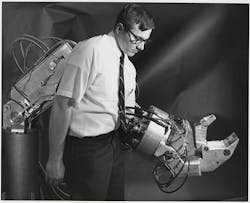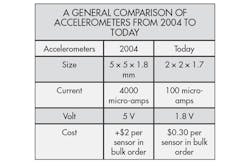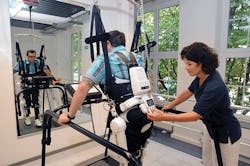Engineers relied heavily on motion-control technology to develop the first wearable exoskeleton at Cornell University, the Hardiman-1, in 1965. The arms, legs, and feet used electrohydraulic servos, while a hydromechanical servo controlled the hands. The hydraulics operated off of a 3,000-psi pump, letting the person in the suit lift up to 1,500 lb and walk at 1.7 mph. The suit itself, however, weighed almost 1500 pounds, making it too heavy and complex to warrant further funding.
Since then, sensors, materials, drives, and power supplies have undergone a host of incremental innovations. Companies developing exoskeletons no longer find it difficult to secure funding. Investors recognize that this technology has many potentially profitable applications. These include letting soldiers carry more weight for longer periods of time, aiding senior citizens and others who suffer musculoskeletal injuries, and giving longshoremen and warehouse workers a competitive advantage in the shipping and trucking industries.
Advancing the Sensor
The human body constantly senses its surroundings and itself to react properly in a wide variety of environments. A constant exchange of information flows between the sense organs, muscles, and brain. Similarly, exoskeletons require a flow of data between sensors and central processor.
Many types of sensors would be required for such a complex machine, and they would have to be small, efficient, and economical.
Fortunately, the trends in sensors are in line with those needs. For example, the Nintendo Wii game controller was introduced with a new accelerometer from ST Microelectronics that was smaller, more sensitive, and demanded less power than previous designs. It was also developed with high-volume production in mind. The silicon wafer from which ICs for the accelerometer was increased from 4 inches in diameter to 8 inches, allowing more “chips” to be made at once. The size of each sensor was also reduced with a new micro-surfacing process that made it possible for ST Microelectronics to make lots of accelerometers for just a few dollars per sensor.
“The Wii controller grabbed the attention of cellphone companies,” said Tony Massimini, CTO of Semico Research. “They realized sensors could add value while maintaining a competitive production cost.”
This file type includes high resolution graphics and schematics when applicable.
The digital frontier was beginning to take hold at this time and it was necessary to develop the ability to communicate between digital and analog components. One of the ways that was done was with sensors called MEMS (micro-electrical-mechanical systems). They generally range from 0.02mm to 1.0mm in size, but include electromechanical components ranging from 0.001 to 1.0mm. The development of MEMS has resulted in countless innovations and improvements in sensor technology.
For example, ST's MEMS digital and analog accelerometers can detect up to ±400g, and measure 2 x 2 x 1 mm. The Kinetis KL02 from Freescale Semiconductor measures less than 2 x 2 x 0.6 mm, while the VL6180X module from STS measures 4.8 x 2.8 x 1.0 mm is an optical sensor that accurately measure distances up to 10 cm.
These improvements mean that multiple sensors can fit in one package. This further reduces size and cost when using “sensor fusion.” Sensor fusion lets two or more sensors work together to improve accuracy or add capabilities. For example, adding a gyroscope to an accelerometer lets the accelerometer compensate for drift and be more precise. Sensor fusion can also add features without adding more sensors, for example, combining an accelerometer with a magnetometer creates an emulated gyroscope.
Sensor fusion also lets microphones do audio beaming. When properly connected, several microphones reduce background noise and locate and identify the sound meant to be heard. Audio equipment that carries out this task can cost over $150 and require a few man hours to set up. Eventually this equipment will likely be replaced with technology in a modern smartphone.
Unfortunately, sensor fusion often requires two chips and customers are stuck with the size and cost of those two chips. To get around this hurdle, companies like mCube are fabricating chips directly on top of the integrated circuits in standard complementary-metal-oxide semiconductor facilities to lower cost and size.
Materials for Exoskeletons |
|
To construct an exoskeleton, engineers will need lightweight materials that can withstand large forces. Materials like steel and aluminum have specific strengths of around 100 to 250 kNm/kg, while fiberglass is around 1,300 kNm/kg. Carbon fiber offers specific strengths of over 2,400 kNm/kg. New technologies, such as carbon nanotube, exceed 40,000 kNm/kg with a tensile strength of 62 GPa. However, much higher strengths might be possible as carbon nanotubes have a theoretical tensile strength of 300 GPa. Cyberdyne’s HAL uses carbon fiber legs, and many other companies use carbon fiber for their suits. New processes and technologies are focusing on cutting weight while increasing strength and mass production. |
Power and Drives
To make a viable exoskeleton, engineers need motors or some other actuators that function quickly to prevent interference with the user’s natural motions. Hydraulics seems like a good way to gain mechanical advantage. Lockheed Martin, for example, has used them in its Human Universal Load Carrier suit.
Today, hydraulics can provide the desired exosuit’s characteristics with open- or closed-loop control. Using both gives users hard set variables (open-loop) and dynamic variables (closed-loop) that adjust as needed.
Electric actuators, another good option, offer features such as variable speed and efficient operation. They are also becoming more “intelligent,” thanks to the addition of sensors, microprocessors, and software.
Although hydraulics looks like the most common drive for exoskeletons, some designers still use electric actuators. Many engineers use both to better combine synthetic and natural motion.
With technology becoming increasingly mobile, battery density has increased over the last decade. In 2007, for example, batteries with an energy density of 600 Wh/L cost about $1,000/kW-hr. By 2013, density had gone to 1,400 Wh/L at a cost of $300/kW-hr.
The higher a battery’s voltage, the shorter its life span tends to be. To sidestep this conundrum, engineers have developed higher-capacity electrodes and anodes. They’ve also devised better chemistries for batteries. Lithium-ion cells, for example, have the highest specific capacity (3,860 mAh/gm). But there are safety concerns about lithium batteries’ charging/discharging cycles. They suffer from thermal run-away and could cause fires. New carbon nano-composites are helping isolate the lithium deposits that build up on the electrode and cause this instability.
Developments and Markets
Lockheed Martin says advancements in motion control are driving factors in exoskeleton development, especially improved hydraulics, and electromyographic (EMG) control, which lets patients control electronics by contracting and relaxing specific muscles. Advances in EMG allow the machine to get ahead of the human in the control loop, thereby reducing lag and the associated metabolic cost of tightening and releasing muscles.
The main problem with EMGs is that it can be difficult to translate their analog frequencies to a drive or digital system. A muscle pulse wavers and can even switch polarity. Rectification, pulse-width modulation, and algorithms are used to “smooth” these signals.
EMG electrodes have been made more sensitive and capable of detecting faint electric pulses through the skin. This is leading defense contractors to work on controls in which human pilots interact with computers to control aircraft by flexing muscles. This technology has caught the eyes of computer gaming companies.
YEI Technology, for example, recently introduced PrioVR, a full-body EMG suit. The company’s goal is to have it to market for under $400, and an upper-body suit for under $270. The equipment could control a video character or an exoskeleton.
ReWalk built an exoskeleton that received FDA approval to be sold as the first motorized device that will act as an exoskeleton for people with lower body paralysis due to spinal cord injury. And in 2009, Cyberdyne said it would build 400 of its Hybrid Assistive Limb suits per year and license them to hospitals for $2,000/month for rehab. Three years later, 130 medical institutions were using it. There are also several robotic companies designing and prototyping exoskeletons that could prevent debilitating muscle injuries, the most common type of on-the-job injury.
In 2011, injuries caused by lifting, pushing, pulling, holding, and carrying costs businesses $14 billion, which was up from $8 billion just two years prior to that in 2009. These injuries and costs are driving the need for exoskeletons that serve as lift-assistance devices.
Another factor driving demand for exoskeletons is the price of fuel. Although gasoline prices are currently low and going lower, higher prices will likely return. This could lead to more U.S.-based shipping lines. To stay competitive, longshoremen wearing exoskeletons could be used to load and unload cargo without undue exhaustion or injury.
Shipping and global competition will make exoskeletons necessary, according to Sean Petterson, CEO of Strong Arm Technologies. Many companies, including Strong Arm Technologies, are working on passive and soft exoskeletons to promote proper posture and form for lifting. With modern materials, some of these devices, like Arm Strong Technology’s V-22, weigh only a few pounds but can lift hundreds.
In September 2014, Defense Advanced Research Project Association gave $2.9 million to researchers at Harvard to develop soft exoskeletons that are comfortable enough to be worn under clothing and reduce exhaustion and injury associated with walking long distances carrying up to 100 lb.
However, costs and design limitations could hamper progress in this area, according to the Journal of Mechanical and Civil Engineering published information on associated design restraints, and costs that might stand in the way of exoskeleton development. Despite these hurdles, the report notes that with 3D printing and rapid prototyping, exoskeletons might soon be a reality.
This file type includes high resolution graphics and schematics when applicable.




